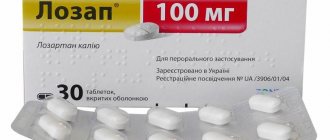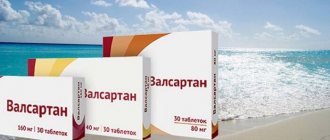Lorista, 100 mg, film-coated tablets, 30 pcs.
More than 20,000 patients took part in studies on the effectiveness and safety of Lorista.
The results of the studies demonstrated the following data:
— in the “Take Off” study, Lorista® (losartan from KRKA) significantly reduced uric acid levels by 32.6% in patients with arterial hypertension (AH) and concomitant hyperuricemia and/or gout. 100% of patients participating in the study achieved the target blood pressure level. Therapy with Lorista has a pronounced positive effect on the elasticity of the vascular wall in patients with hypertension1;
— in the open-label multicenter clinical trial LAURA2 (Lorista® and uric acid), the relationship between treatment with Lorista and its fixed combination with hydrochlorothiazide (Lorista® H and Lorista® HD) and hyperuricemia was studied. Based on the results of the study in patients with hypertension and hyperuricemia, Lorista®, Lorista® H and Lorista® ND, due to their apparent ability to lower uric acid levels, can be used as the preferred therapy;
— the EFFECT3 study proved the effectiveness and safety of losartan (Lorista®) in patients with mild and moderate hypertension. In addition, it is important to emphasize the safety of using Lorista (adverse effects in less than 1% of patients), which makes the drug an indispensable assistant in the fight against hypertension;
— as a result of the international study Gemera4, the effectiveness and safety of the use of Lorista® and a fixed combination with hydrochlorothiazide (Lorista® N) in patients with stage 1–2 hypertension was confirmed. 100% of patients achieved CAP.
The results of clinical studies conducted with the drug KRKA Lorista (losartan) and its fixed combinations with hydrochlorothiazide further indicate that the drug contributes not only to the effective and well-tolerated treatment of hypertension, but also to the reduction of cardiovascular risk.
Literature
1. Nedogoda S.V., Ledyaeva A.A., Chumachok E.V., Tsoma V.V., Salasyuk A.S. Possibilities of losartan in angioprotection against hyperuricemia in patients with arterial hypertension. Systemic hypertension. - 2012. - No. 4. - P.50–54.
2. Svishchenko E.P., Bezrodnaya L.V., Gorbas I.M. Clinical and uricosuric efficacy of losartan in patients with arterial hypertension. Results of the open multicenter clinical trial LAURA. Arterial hypertension.- 2012.- 5 (25).- P.25–32.
3. Drapkina O.M., Kozlova E.V. The place of angiotensin receptor antagonists in the treatment of cardiovascular diseases. Study EFFECT: use of Lorista in patients with mild and moderate arterial hypertension in real clinical practice. Problems of women's health.- 2009.- 4(4).- P.17–26.
4. Chazova I.E., Martynyuk T.V. Federal State Budgetary Institution Russian Cardiology Research and Production Complex of the Ministry of Health of the Russian Federation, Moscow. First results of the international clinical trial GEMERA: two therapeutic regimens for the effective treatment of patients with stage 1–2 arterial hypertension.
Lorista N (tab.p.pl/vol. 100 mg + 12.5 mg No. 30)
A country
Slovenia
The country of production may vary depending on the batch of goods. Please check with the operator for detailed information when confirming your order.
Active substance
Losartan + Hydrochlorothiazide
Compound
Active ingredients: losartan potassium 50 mg, hydrochlorothiazide 12.5 mg.
pharmachologic effect
Pharmacodynamics. Lorista N is a combination drug; has a hypotensive effect. Losartan is a selective angiotensin II receptor antagonist (AT1 type) for oral administration, of a non-protein nature. In vivo and in vitro, losartan and its biologically active carboxyl metabolite (EXP-3174) block all physiologically significant effects of angiotensin II on AT1 receptors, regardless of the route of its synthesis: it leads to an increase in the activity of plasma renin, reduces the concentration of aldosterone in the blood plasma, etc. Losartan indirectly causes activation of AT2 receptors by increasing the level of angiotensin II. Losartan does not suppress the activity of kininase II, an enzyme that is involved in the metabolism of bradykinin. Reduces total peripheral vascular resistance (TPVR), pressure in the “lesser” circulation; reduces afterload, has a diuretic effect. Prevents the development of myocardial hypertrophy, increases exercise tolerance in patients with chronic heart failure (CHF). Taking losartan once a day leads to a statistically significant decrease in systolic and diastolic blood pressure (BP). Losartan evenly controls blood pressure throughout the day, while the antihypertensive effect corresponds to the natural circadian rhythm. The decrease in blood pressure (BP) at the end of the drug dose was approximately 70-80% of the effect at the peak of the drug effect, 5-6 hours after administration. There is no “withdrawal” syndrome; losartan also does not have a clinically significant effect on heart rate (HR). Losartan is effective in men and women, as well as in elderly (> 65 years) and younger patients (Indications for use Arterial hypertension (patients who are indicated for combination therapy). Reducing the risk of cardiovascular morbidity and mortality in patients with arterial hypertension and left hypertrophy ventricle
Mode of application
Inside, regardless of food intake. The drug can be combined with other antihypertensive drugs. Arterial hypertension. The initial and maintenance dose is 1 tablet of the drug (50/12.5 mg) 1 time per day. The maximum antihypertensive effect is achieved within three weeks of therapy. To achieve a more pronounced effect, it is possible to increase the dose of the drug to 2 tablets (50/12.5 mg) once a day. The maximum daily dose is 2 tablets of the drug. In patients with a reduced circulating blood volume (for example, while taking large doses of diuretics), the recommended initial dose of losartan in patients with hypovolemia is 25 mg once a day. In this regard, therapy should be started after discontinuation of diuretics and correction of hypovolemia. In elderly patients and patients with moderate renal impairment, including those on dialysis, no adjustment of the initial dose is required. Reducing the risk of cardiovascular morbidity and mortality in patients with arterial hypertension and left ventricular hypertrophy. The standard initial dose of losartan is 50 mg 1 time per day . Patients who fail to achieve target blood pressure levels while taking losartan 50 mg/day require selection of therapy by combining losartan with low doses of hydrochlorothiazide (12.5 mg), and, if necessary, the dose of losartan should be increased to 100 mg per day. combination with hydrochlorothiazide at a dose of 12.5 mg/day, in the future - increase to 2 tablets of the drug 50/12.5 mg in total (100 mg of losartan and 25 mg of hydrochlorothiazide per day once).
Interaction
Losartan. Clinical studies of pharmacokinetic interactions did not reveal clinically significant interactions of the drug with hydrochlorothiazide, digoxin, warfarin, cimetidine, phenobarbital, ketoconazole and erythromycin. Rifampicin and fluconazole reduce the level of the active metabolite (this interaction has not been clinically studied). The combination of losartan with potassium-sparing diuretics (spironolactone, triamterene, amiloride), potassium-sparing supplements or potassium salts may lead to hyperkalemia. NSAIDs, including selective cyclooxygenase-2 inhibitors, may reduce the effect of diuretics and other antihypertensive agents, including losartan. In patients with impaired renal function who have been treated with NSAIDs (including cyclooxygenase-2 inhibitors), therapy with angiotensin II receptor antagonists may lead to further deterioration of renal function, including acute renal failure, which is usually reversible. The hypotensive effect of losartan, like other antihypertensive drugs, may be reduced when taking indomethacin. Hydrochlorothiazide. With thiazide diuretics, drugs such as ethanol, barbiturates and narcotics may potentiate the risk of orthostatic hypotension. Hypoglycemic agents (oral and insulin) - dosage adjustment of hypoglycemic agents may be required. Other antihypertensive drugs - additive effect. Cholestyramine and colestipol - in the presence of anion exchange resins, the absorption of hydrochlorothiazide is impaired. Corticosteroids, ACTH (adrenocorticotropic hormone) - a marked decrease in electrolyte levels, in particular hypokalemia. Pressor amines (for example, epinephrine, norepinephrine) - a decrease in the severity of the response to take pressor amines. Non-depolarizing muscle relaxants (for example, tubocurarine) - enhance the effect of muscle relaxants. Lithium - diuretics reduce the renal clearance of lithium and increase the risk of developing the toxic effect of lithium; simultaneous use is not recommended. NSAIDs (including cyclooxygenase-2 inhibitors) - may reduce the diuretic, natriuretic and hypotensive effects of diuretics. Due to their effect on calcium metabolism, their intake may distort the results of studies of parathyroid function.
Side effect
From the blood and lymphatic system: uncommon: anemia, Henoch-Schönlein purpura. From the immune system: rare: anaphylactic reactions, angioedema (including swelling of the larynx and tongue, causing obstruction of the airways and/or swelling of the face, lips, pharynx). From the central nervous system and peripheral nervous system: often: headache, systemic and non-systemic dizziness, insomnia, fatigue; infrequently: migraine. From the cardiovascular system: often: orthostatic hypotension (dose-dependent), palpitations, tachycardia; rare: vasculitis. From the respiratory system: often: cough, upper respiratory tract infections, pharyngitis, swelling of the nasal mucosa. From the gastrointestinal tract: often: diarrhea, dyspepsia, nausea, vomiting, abdominal pain. From the hepatobiliary systems: rarely: hepatitis, liver dysfunction. From the skin and subcutaneous fat: infrequently: urticaria, itching. From the musculoskeletal system and connective tissue: often: myalgia, back pain; uncommon: arthralgia. Other: common: asthenia, weakness, peripheral edema, chest pain. Laboratory indicators: common: hyperkalemia, increased hemoglobin concentration and hematocrit (not clinically significant); uncommon: moderate increase in serum urea and creatinine levels; very rarely: increased activity of liver enzymes and bilirubin.
Contraindications
Hypersensitivity to losartan, to drugs that are sulfonamide derivatives and other components of the drug, anuria, severe renal dysfunction (creatinine clearance (CC) less than 30 ml/min.), hyperkalemia, dehydration (including while taking high doses of diuretics) , severe liver dysfunction, refractory hypokalemia, pregnancy, lactation, arterial hypotension, age under 18 years (efficacy and safety have not been established), lactase deficiency, galactosemia or glucose/galactose malabsorption syndrome. With caution: disturbances in the water-electrolyte balance of the blood ( hyponatremia, hypochloremic alkalosis, hypomagnesemia, hypokalemia), bilateral renal artery stenosis or stenosis of the artery of a single kidney, diabetes mellitus, hypercalcemia, hyperuricemia and/or gout, aggravated allergic history (in some patients, angioedema developed earlier when taking other drugs, including including ACE inhibitors) and bronchial asthma, systemic blood diseases (including systemic lupus erythematosus), simultaneous administration of non-steroidal anti-inflammatory drugs (NSAIDs), including cyclooxygenase-II inhibitors (COX-2 inhibitors). Use during pregnancy and during lactation. There are no data on the use of losartan during pregnancy. Fetal renal perfusion, which depends on the development of the renin-angiotensin system, begins to function in the third trimester of pregnancy. The risk to the fetus increases when losartan is taken in the second and third trimesters. If pregnancy is established, therapy should be stopped immediately. If it is necessary to prescribe the drug during lactation, breastfeeding must be stopped.
Overdose
Losartan. Symptoms: marked decrease in blood pressure, tachycardia; bradycardia due to parasympathetic (vagal) stimulation. Treatment: forced diuresis, symptomatic therapy, hemodialysis is ineffective. Hydrochlorothiazide. Symptoms: the most common symptoms are a consequence of electrolyte deficiency (hypokalemia, hypochloremia, hyponatremia) and dehydration due to excessive diuresis. When taking cardiac glycosides simultaneously, hypokalemia may aggravate the course of arrhythmias. Treatment: symptomatic.
special instructions
Can be prescribed together with other antihypertensive drugs. There is no need for special selection of the initial dose for elderly patients. The drug may increase the concentration of urea and creatinine in the blood plasma in patients with bilateral renal artery stenosis or renal artery stenosis of a single kidney. Hydrochlorothiazide may increase arterial hypotension and water-electrolyte imbalance (decreased circulating blood volume, hyponatremia, hypochloremic alkalosis, hypomagnesemia, hypokalemia) , impair glucose tolerance, reduce the excretion of calcium in the urine and cause a transient, slight increase in the concentration of calcium in the blood plasma, increase the concentration of cholesterol and triglycerides, provoke the occurrence of hyperuricemia and/or gout. Taking medications that directly act on the renin-angiotensin system during the second and third trimesters of pregnancy can lead to fetal death. If pregnancy occurs, discontinuation of the drug is indicated. For pregnant women, the use of diuretics is usually not recommended due to the risk of jaundice in the fetus and newborn, platelet swelling in the mother. Diuretic therapy does not prevent the development of toxicosis of pregnancy. Special warnings regarding excipients. The drug contains lactose, therefore cannot be prescribed for the following conditions: lactase deficiency, galactosemia or glucose/galactose malabsorption syndrome. Effect on the ability to drive a car and other mechanisms. Almost all During therapy, patients may perform tasks that require increased attention (for example, driving a car). In some individuals, at the beginning of therapy, the drug can cause a decrease in blood pressure and dizziness, thus indirectly affecting their psycho-emotional state. For safety reasons, patients should first assess their response to treatment before engaging in activities requiring increased alertness.
Dispensing conditions in pharmacies
On prescription
Lorista
Lorista (active ingredient - losartan) is an antihypertensive drug, an angiotensin II receptor blocker with selective action (it exhibits antagonism exclusively to AT1 type receptors). Medicines for the treatment of cardiovascular diseases are today, perhaps, the most popular part of the pharmacy assortment, occupying the largest area on display windows. This is not surprising: cardiovascular pathology is currently firmly entrenched in the sole leading position in the structure of overall mortality, exceeding similar indicators from all other possible causes combined. The antihypertensive effect of Lorista is based on the ability of the drug to erect an insurmountable barrier between AT1 receptors and angiotensin II, thereby blocking all physiologically significant effects of the latter, regardless of the route of its formation in the body. Thus, angiotensin II cannot realize its remarkable vasopressor potential, although its amount does not decrease, as occurs with treatment with angiotensin-converting enzyme inhibitors. It is important that, unlike the latter, Lorista does not inhibit the enzyme kininase II, which is involved in the metabolism of bradykinin. As a result, there is no accumulation of excess bradykinin, which avoids the associated side effects of cough and angioedema. Lorista reduces total peripheral vascular resistance, pressure in the pulmonary circulation, reduces afterload on the myocardium, and has a moderate diuretic effect. The drug prevents the development and progression of left ventricular hypertrophy (a predictor of cardiovascular events) and increases resistance to physical exercise in patients suffering from chronic heart failure. In order to achieve a clinically significant reduction in systolic (upper) and diastolic (lower) blood pressure, it is enough to take Lorista once a day. The drug maintains blood pressure at a given level throughout the day, without sudden changes and in accordance with the natural circadian rhythm.
The decrease in blood pressure at the end of a single dose of Lorista is about 70-80% of the antihypertensive effect 5-6 hours after administration, when the peak effect of the drug is noted. The drug does not cause a reflex increase in heart rate and a rebound increase in blood pressure after cessation of pharmacotherapy. Lorista is effective in patients regardless of their gender and age. One of the main studies demonstrating the effectiveness of the drug in arterial hypertension was the multicenter randomized LIFE trial. It involved more than 9 thousand patients who, in addition to persistently elevated blood pressure, also had left ventricular hypertrophy. Study participants were divided into two groups taking losartan (Lorista) and atenolol, respectively. When analyzing the study results, it was found that mortality in the losartan group was almost two times lower than in the atenolol group. Patients in the losaratan group were less likely to develop cardiovascular events such as ischemic stroke and acute myocardial infarction. The dynamics of the decrease in blood pressure were comparable in both groups, while in the losaratan group, patients experienced a much more pronounced regression of left ventricular hypertrophy. Thus, Lorista has proven to be a more promising drug in the treatment of arterial hypertension than atenolol. In general, Lorista, as well as all sartans (as the group of angiotensin II receptor blockers is more compactly called), is better tolerated than other groups of antihypertensive drugs. If we talk exclusively about losartan (lorist), then this drug has the most solid evidence base among all sartans, being the most studied representative of this group of drugs and having the largest number of indications for use.
Lorista ND tablets ppo 100mg+25mg No. 90
Interaction
Concomitant use with aliskiren in patients with diabetes mellitus or impaired renal function (creatinine clearance less than 60 ml/min) is contraindicated.
Rifampicin and fluconazole reduced the concentration of the active metabolite. The clinical significance of this interaction has not been studied. Concomitant use of losartan, as well as other drugs that affect the RAAS, with potassium-sparing diuretics (spironolactone, triamterene, amiloride, eplerenone), potassium supplements or salt substitutes containing potassium ions can lead to an increase in serum potassium levels. Simultaneous use is not recommended.
Possible reduction in the excretion of lithium ions. Therefore, when using angiotensin II receptor antagonists concomitantly with lithium salts, serum lithium concentrations should be carefully monitored. With simultaneous use of angiotensin II antagonists with non-steroidal anti-inflammatory drugs (NSAIDs) (for example, selective cyclooxygenase (COX)-2 inhibitors, and non-selective NSAIDs, high doses (more than 3 g / day) of acetylsalicylic acid), the antihypertensive effect may be reduced.
The simultaneous use of angiotensin II antagonists or diuretics with NSAIDs is accompanied by an increased risk of developing renal dysfunction, incl. the development of acute renal failure, and an increase in serum potassium levels (especially in patients with a history of renal dysfunction).
Concomitant use with NSAIDs should be done with caution, especially in elderly patients. In this case, it is necessary to adequately replenish the volume of blood volume and periodically monitor renal function from the moment of initiation of therapy and subsequently. In some patients with impaired renal function using NSAIDs, incl. selective COX-2 inhibitors, simultaneous use of angiotensin II receptor antagonists may cause further reversible deterioration of renal function. Double blockade of the RAAS: double blockade of the RAAS, i.e. the addition of an ACE inhibitor to therapy with an angiotensin II receptor antagonist is possible only in selected cases under careful monitoring of renal function.
In patients with atherosclerosis, heart failure or diabetes mellitus with target organ damage, double blockade of the RAAS (with simultaneous use of angiotensin II receptor antagonists, ACE inhibitors or aliskiren) is accompanied by an increased incidence of arterial hypotension, syncope, hyperkalemia and renal dysfunction (including acute renal disease). deficiency) in comparison with the use of a drug from one of the listed groups.
Other drugs that cause hypotension, including tricyclic antidepressants, antipsychotics, baclofen, amifostine: simultaneous use of drugs that lower blood pressure (main or side effect) may increase the risk of developing arterial hypotension.
Hydrochlorothiazide Ethanol, barbiturates, general anesthetics or antidepressants: may potentiate the risk of orthostatic hypotension. Oral hypoglycemic agents and insulin: dose adjustment of hypoglycemic agents may be required because hydrochlorothiazide affects glucose tolerance.
Metformin should be used with caution due to the risk of lactic acidosis due to renal impairment caused by hydrochlorothiazide. Other antihypertensive drugs: additive effect. Cholestyramine and colestipol: absorption of hydrochlorothiazide is reduced. Cholestyramine and colestipol in a single dose bind hydrochlorothiazide and reduce its absorption in the gastrointestinal tract (GIT) by 85 and 43%, respectively.
Corticosteroids, adrenocorticotropic hormone (ACTH): marked reduction in electrolytes, especially hypokalemia. Pressor amines (for example, epinephrine and norepinephrine): a slight decrease in the severity of the response to the administration of pressor amines is possible, but does not preclude their use. Non-depolarizing muscle relaxants (for example, tubocurarine): the effect of muscle relaxants may be enhanced.
Lithium: there may be a decrease in the renal clearance of lithium and, accordingly, the risk of developing lithium intoxication. Therefore, simultaneous use is not recommended. Medicines used to treat gout (probenecid, sulfinpyrazone and allopurinol): Dosage adjustment of uricosuric drugs may be required as hydrochlorothiazide may cause an increase in serum uric acid concentrations. Thiazide diuretics may increase the incidence of hypersensitivity reactions to allopurinol.
Anticholinergic drugs (eg, atropine, biperiden): increase the bioavailability of thiazide diuretics by reducing gastrointestinal motility. Cytostatic drugs, for example, cyclophosphamide, methotrexate: the myelosuppressive effect increases by slowing elimination from the body.
Salicylates: when used simultaneously with salicylates (for example, acetylsalicylic acid) in high doses, their toxic effect on the central nervous system may be enhanced. Methyldopa: Isolated cases of hemolytic anemia have been described during concomitant use. Concomitant use of cyclosporine increases the risk of developing hyperuricemia and exacerbation of gout;
Cardiac glycosides: Hypokalemia and hypomagnesemia caused by the use of thiazide diuretics increase the risk of arrhythmias when treated with cardiac glycosides. Drugs that may cause side effects when serum potassium levels change: It is recommended to periodically monitor serum potassium levels and ECGs when used concomitantly with cardiac glycosides and drugs that prolong the QT interval (risk of developing torsade de pointes (TdP):
- I A class of antiarrhythmic drugs (for example, quinidine, disopyramide);
- Class III antiarrhythmic drugs (for example, amiodarone, sotalol, dofetilide);
- Some antipsychotics (for example, thioridazine, chlorpromazine, levomepromazine, trifluoperazine, sulpiride, amisulpride, tiapride, haloperidol, droperidol);
- Other drugs (eg, cisapride, difemanil methyl sulfate, erythromycin intravenous, halofantrine, ketanserin, mizolastine, terfenadine, sparfloxacin, vincamine intravenous).
Vitamin D and calcium salts: simultaneous use of thiazide diuretics with vitamin D or calcium salts increases the calcium level in the blood serum, because calcium excretion decreases. If it is necessary to use calcium or vitamin D supplements, the calcium level in the blood serum should be monitored and, possibly, the dose of these drugs should be adjusted.
Carbamazepine: risk of developing symptomatic hyponatremia. It is necessary to monitor blood pressure and clinical signs of impaired water and electrolyte metabolism. Serum electrolyte levels should also be periodically monitored.
Hydrochlorothiazide may increase the risk of acute renal failure, especially when used concomitantly with high doses of iodinated contrast agents. Before using them, it is necessary to restore the bcc. Amphotericin B (intravenous), stimulant laxatives, or ammonium glycyrrhizinate (found in licorice): Hydrochlorothiazide may increase electrolyte disturbances, especially hypokalemia.
Nonsteroidal anti-inflammatory drugs (NSAIDs) NSAIDs (for example, selective COX-2 inhibitors, and non-selective NSAIDs, high doses (more than 3 g / day) of acetylsalicylic acid) may reduce the diuretic and antihypertensive effects of thiazide diuretics.




